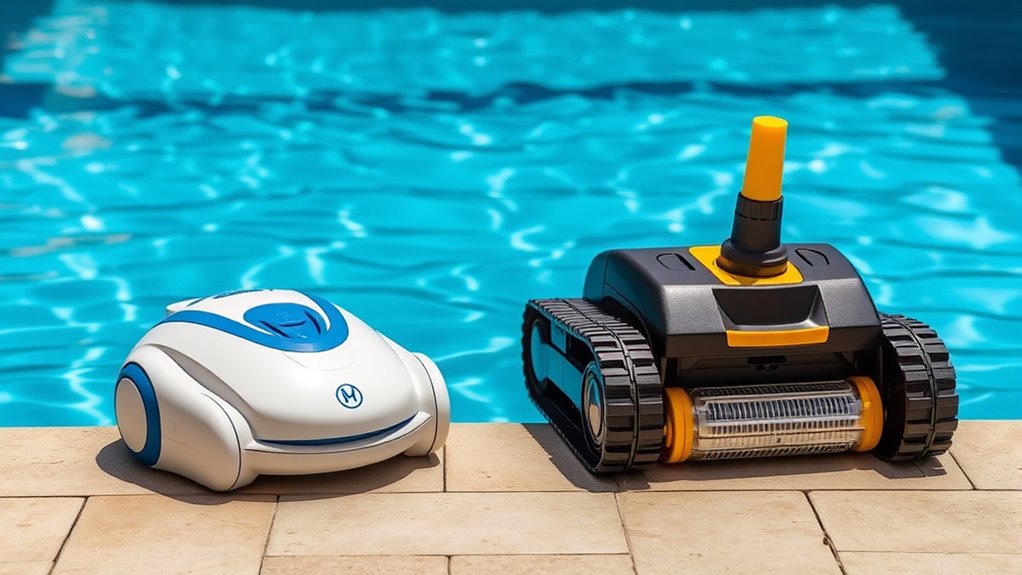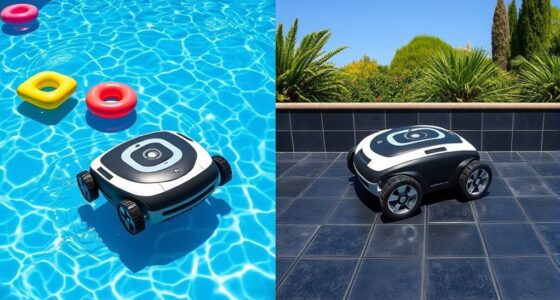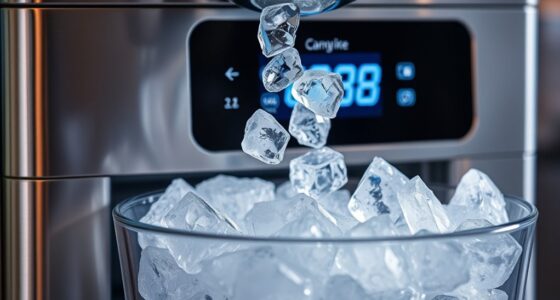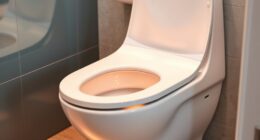Robotic pool cleaners are energy-efficient, easy to maintain, and provide thorough cleaning thanks to advanced navigation systems. They run independently and can often cover the entire pool surface more effectively than suction models. Suction cleaners are usually cheaper upfront but depend on your pool’s pump, which increases energy use and maintenance costs over time. If you’d like to discover which option best fits your needs and budget, keep exploring the details below.
Key Takeaways
- Robotic cleaners offer independent operation, thorough coverage, and lower maintenance, while suction cleaners depend on pool pumps and may need frequent upkeep.
- Robotic models are more energy-efficient and cost-effective long-term, whereas suction cleaners increase energy use and potential repair costs.
- Robotic units provide better navigation and cleaning coverage, reducing manual intervention compared to suction cleaners’ limited patterns.
- Initial investment in robotic cleaners is higher but often results in savings, while cheaper suction cleaners may incur higher long-term expenses.
- Robotic cleaners operate quietly with fewer plumbing parts, minimizing wear and tear, unlike suction models that rely heavily on pool pump systems.

Are robotic and suction pool cleaners truly different, or just variations of the same idea? It’s a common question, especially when you’re trying to decide which type fits your needs best. Both options aim to keep your pool clean, but they approach the task differently, affecting factors like energy efficiency and maintenance costs. Understanding these differences helps you make an informed choice that saves you money and effort over time.
Robotic pool cleaners operate independently of your pool’s filtration system. They come with their own power supply and are equipped with advanced navigation systems that allow them to methodically cover the entire pool surface. Because they are self-contained, robotic cleaners tend to be more energy-efficient—they don’t rely on your pool pump, which often runs at higher power levels and consumes more electricity. This means you can run a robotic cleaner for longer periods without notably increasing your energy bill. Additionally, since robotic cleaners are built with fewer moving parts connected to your pool’s plumbing, their maintenance costs are generally lower. You won’t need to worry about replacing hoses, seals, or dealing with frequent pump repairs, which are common with some suction models.
Robotic pool cleaners are self-contained, energy-efficient, and require less maintenance than suction models.
Suction pool cleaners, on the other hand, connect directly to your pool’s skimmer or dedicated suction line. They use the power of your pool’s existing filtration system to move around and collect debris. While this setup can initially be cheaper, it often leads to higher maintenance costs over time. Your pool’s pump works harder when running a suction cleaner, which may lead to increased energy consumption and wear and tear on your system. Plus, since suction cleaners rely on the flow of water through their hoses and mechanisms, they can become clogged or need regular cleaning and replacement of parts like brushes or filters. Their cleaning patterns are typically less thorough, often requiring manual intervention or multiple passes to cover the entire pool surface comprehensively. Advances in robotic technology have further improved their navigation and cleaning capabilities, making them a more attractive option for many pool owners.
In terms of energy efficiency, robotic cleaners are generally the better choice, especially if you’re looking to minimize electricity use. Their independent operation means they don’t tax your pool’s filtration system, leading to lower energy bills and less strain on your equipment. When it comes to maintenance costs, robotic cleaners tend to be more economical because they are simpler to service, with fewer parts subject to wear from water pressure and debris. Conversely, suction cleaners may seem more affordable upfront but can end up costing more in repairs and increased energy use over the long haul.
Ultimately, your decision hinges on your priorities. If you want a cleaner that works quietly, efficiently, and with less ongoing expense, a robotic pool cleaner could be the smarter investment. If budget constraints are tight and you’re willing to handle more frequent maintenance, a suction cleaner might suffice.
Frequently Asked Questions
Which Cleaner Is More Energy-Efficient for Long-Term Use?
When considering long-term use, you wonder which cleaner is more energy-efficient. You should look at energy consumption and power efficiency. Robotic pool cleaners typically use less energy because they operate with smart technology and optimized motors, saving power over time. Suction cleaners might consume more energy due to continuous operation and less advanced systems. For better long-term savings, a robotic cleaner generally offers improved power efficiency, reducing your energy costs.
How Often Should Each Type of Cleaner Be Maintained?
Ever wondered how often you should maintain your pool cleaner? It depends on your cleaner type. For robotic cleaners, follow the manufacturer’s cleaning schedule—typically once a week—while checking brushes and filters regularly. Suction cleaners need more frequent maintenance—about every 2-3 weeks—cleaning filters and inspecting hoses. Stay proactive; preserving your cleaner properly ensures it performs at its best and keeps your pool sparkling.
Can Robotic and Suction Cleaners Be Used Together?
Yes, you can use robotic and suction cleaners together, but it’s important to verify pool cleaning compatibility and cleaner integration options first. Using both can enhance your pool’s cleanliness, with each tackling different debris and areas. Make certain your pool’s filtration system supports simultaneous operation, and set schedules to avoid conflicts. This combination can result in a more thorough clean, saving you time and effort.
Are There Specific Pool Sizes Better Suited for Each Cleaner?
You’ll find that pool size suitability influences which cleaner works best. For smaller pools, suction cleaners are often more compatible because they efficiently handle limited space without extra features. Larger pools benefit from robotic cleaners, as they cover more area and handle complex shapes. Consider your pool’s size and shape to determine cleaner compatibility, ensuring you select a device that effectively cleans your pool without unnecessary strain or limitations.
What Is the Typical Lifespan of Robotic Versus Suction Pool Cleaners?
You wonder about the lifespan of robotic versus suction pool cleaners. Generally, robotic cleaners have a longer lifespan, often lasting 3-5 years with proper maintenance, while suction cleaners last around 2-3 years. Maintenance frequency plays a key role; robotic models need regular brush and filter checks, whereas suction types require less frequent upkeep. In a lifespan comparison, robotic cleaners tend to be more durable and cost-effective over time.
Conclusion
Choosing between robotic and suction pool cleaners is like picking between a trusty steed and a diligent worker bee. Both have their strengths, but ultimately, your pool’s health depends on the right fit for your needs. Think of it as tending a garden—you need the right tools to keep it thriving. Whichever you choose, remember that a clean pool is your personal oasis, a shimmering mirror reflecting your care and effort.









